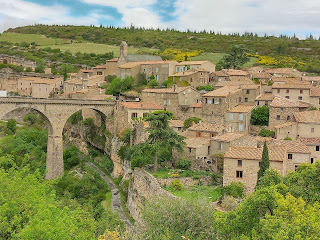Not the greatest weather today, partly sunny but not very warm. Today's agenda is quite full: Oulibo olive cooperative for Lucques olives, a visit to Minerve, find the Dolmen de Fados, and do some wine-tasting on the way home.
Lucques olives are unlike any olive I've ever tasted. They are bright green, mild in flavor, with a firm flesh and very little saltiness.
We first met Lucques in 2011, our first trip to the Languedoc area. They are only grown in the south of France and unavailable in US stores as far as we know. However, I did find some on Amazon (of course) but they look expensive. In Bize-Minerves, there is an olive cooperative called Oulibo.
It's the best place to buy large amounts of Luques olives for a reasonable price. They are available from olive vendors at the markets, but their prices are a bit higher. Of course we bought the large jar.
 |
| Dave picking up our Lucques olives |
Back on the road, we headed toward Minerve, a Plus Beau Village with a dramatic setting and an equally dramatic history. The village perches atop a rocky outcropping above a gorge carved by two converging rivers, the Cesse and the Briant.
These rivers flow through two natural bridges at the bottom of the gorge, easily accessible if you're up for a hike and willing to get your feet wet.
 |
| Kim and Janis hiking down to the river |
 |
| Kim collecting stones at the river |
 |
| One of the natural bridges on the left and the man-made bridge on the right |
The 99 inhabitants of this village depend on tourism and wine making for their economic viability. Their classification among the Plus Beaux Villages de France encourages more than 300,000 visitors each year.
Crossing the stone bridge is only allowed for residents.
Visitors climb up above the town to a discretely hidden paid parking area and then walk down into the city.
 |
| Lynn, Dale, Kim, and Clark walking down into the village |
 |
| Dave and Janis at the entry to the village |
This small village takes only a short time to traverse, but the views are stunningly beautiful and the history that unfolds in the 13th century is tragic. Minerve, like so many towns and villages of southern France, housed many Cathars whose break with Catholicism caused the Pope to declare a crusade to eliminate the heretics. But it's location and fortifications made Minerve seem impregnable.
Nevertheless, Simon de Montfort and the crusaders set up 4 trebuchets across the gorge from Minerve and began pounding its walls with huge boulders, strategically taking out Minerve's wells, the towns only source of drinking water.
 |
| Trebuchets like this one pounded Minerve from the opposite side of the gorge |
The town capitulated after 5 weeks. 140 Cathars who refused to recant their religion were burned at the stake. Near the church, a dove carved into rock memorializes the loss of the Cathars of Minerve.
 |
| memorial to the Cathar martyrs |
The castle was destroyed during the siege as was much of the village.
During the middle ages, Minerve was assaulted regularly by brigands, troops of the wars of religion, and changing power structures among the ruling class. Somehow, the town continued and today tourism provides economic support for the town.
 |
| a bar and ice cream restaurant |
Like every town and village in France, Minerve has a memorial to the village's soldiers who died in WWI and later wars. The list of WWI names is always much longer than any of the other wars, a testament of the devastation Europe sustained in WWI.
 |
| I always stop for a quiet minute at these war memorials. They always cause me to reflect on the cost of war. |
It's a town worth lingering over.
 |
| Clark, Dave, and Dale |
 |
| view from the bridge |
We even found a place to eat our picnic lunch.
 |
| Kim, Dale, Dave |
 |
| Dave, Janis, and Clark |
We still have 2 more stops today, so it's time to head off in search of the Dolmen de Fados (Dolmen of the Fairies). Dolmens are funereal chambers built with stone slabs for sides and top. Located not far from Minerve and dating from 3500 BC, this dolmen is the largest in southern France. The roofstone is estimated to be 25-30 tons, its type of stone found no nearer than 2 miles away. It's hard to imagine how people without iron tools could have pried this stone from the earth, moved it, and then placed it atop the dolmen.
Our last stop of the day is in Peyriac-Minervois, wine-tasting at Tour St. Martin, a wine cooperative for Minervois wines.
A perfect ending for our tour of the area around Minerve. Wine cooperatives are facilities owned by the growers to share production costs. They hire a winemaker who manages the production, aging, and bottling of the wines sold by the cooperative. It is a way to support and encourage small growers to earn a living from their vineyards. About half the wine made in France is produced by cooperatives.
So of course we tasted wine and then bought a case to take with us.
Wine cooperatives often sell wine in "vrac" where one brings one's own container which is filled directly from the vats for a cheaper price. Many places have stopped this practice in favor of the more sanitary BIB (bag in box).
 |
| vrac is sold by weight not by volume. |
Finally at home, it's time for aperos on the patio.



















No comments:
Post a Comment